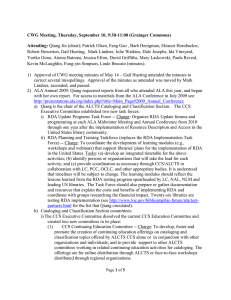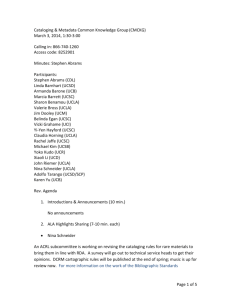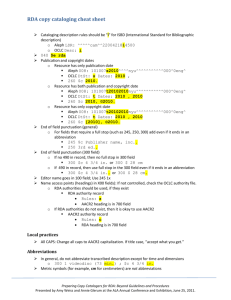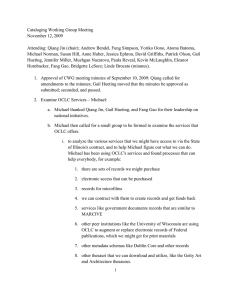Cataloging Working Group Meeting 8 July 2010
advertisement
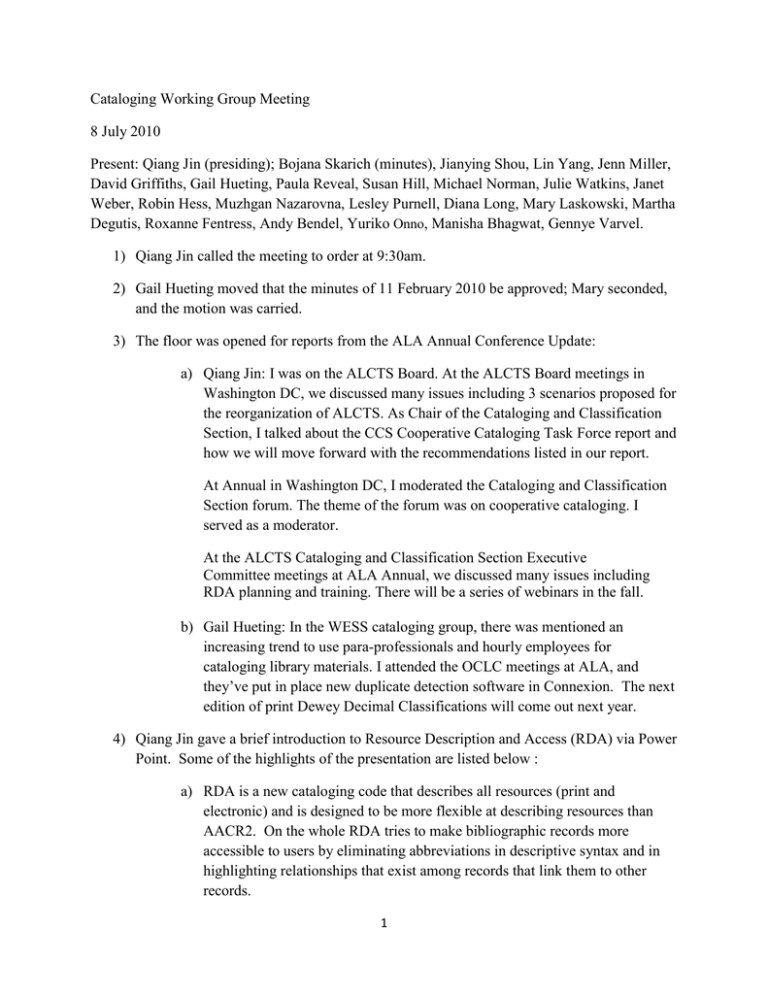
Cataloging Working Group Meeting 8 July 2010 Present: Qiang Jin (presiding); Bojana Skarich (minutes), Jianying Shou, Lin Yang, Jenn Miller, David Griffiths, Gail Hueting, Paula Reveal, Susan Hill, Michael Norman, Julie Watkins, Janet Weber, Robin Hess, Muzhgan Nazarovna, Lesley Purnell, Diana Long, Mary Laskowski, Martha Degutis, Roxanne Fentress, Andy Bendel, Yuriko Onno, Manisha Bhagwat, Gennye Varvel. 1) Qiang Jin called the meeting to order at 9:30am. 2) Gail Hueting moved that the minutes of 11 February 2010 be approved; Mary seconded, and the motion was carried. 3) The floor was opened for reports from the ALA Annual Conference Update: a) Qiang Jin: I was on the ALCTS Board. At the ALCTS Board meetings in Washington DC, we discussed many issues including 3 scenarios proposed for the reorganization of ALCTS. As Chair of the Cataloging and Classification Section, I talked about the CCS Cooperative Cataloging Task Force report and how we will move forward with the recommendations listed in our report. At Annual in Washington DC, I moderated the Cataloging and Classification Section forum. The theme of the forum was on cooperative cataloging. I served as a moderator. At the ALCTS Cataloging and Classification Section Executive Committee meetings at ALA Annual, we discussed many issues including RDA planning and training. There will be a series of webinars in the fall. b) Gail Hueting: In the WESS cataloging group, there was mentioned an increasing trend to use para-professionals and hourly employees for cataloging library materials. I attended the OCLC meetings at ALA, and they’ve put in place new duplicate detection software in Connexion. The next edition of print Dewey Decimal Classifications will come out next year. 4) Qiang Jin gave a brief introduction to Resource Description and Access (RDA) via Power Point. Some of the highlights of the presentation are listed below : a) RDA is a new cataloging code that describes all resources (print and electronic) and is designed to be more flexible at describing resources than AACR2. On the whole RDA tries to make bibliographic records more accessible to users by eliminating abbreviations in descriptive syntax and in highlighting relationships that exist among records that link them to other records. 1 b) RDA was developed by the Joint Steering Committee of International Federation of Library Associations (IFLA) to replace the Anglo-American Cataloging Rules, (AACR), which were first published in 1978. c) RDA is based on the FRBR (Functional Requirements for Bibliographic Records) model, which is based on an entity-relationship model. Types of entities include “work,” “expression,” “manifestation” and “item.” d) RDA’s major impact on University of Illinois’ libraries are the following: Testing outcomes with RDA Voyager updates to incorporate RDA into our system OCLC updates Local policies and decisions on workflows 5) Qiang Jin said that the RDA Toolkit came out on June 23rd in online form only. RDA implementation at the University of Illinois is set to begin late in the year 2011, and formal testing and assessment are to begin in October 2010 and March 2011, respectively at the national level. Janet Weber mentioned that there are 7 RDA testers at the library working with Graduate School of Library and Information Science (GLSIS) 6) Janet Weber showed those in attendance how to access the RDA Toolkit : Go to www.rdatoolkit.org and click on the big blue button on the top left of the screen. Create a user login profile by clicking on the “Create” button on the top right of the screen. The computer should then display your login name at the top right of the screen. Utilize the training resources at http://www.rdatoolkit.org/ by clicking on the “Teaching & Training” link on the bottom left of the screen. 7) Jenn Miller talked in more detail about the RDA website layout by discussing the way one could search for terms and locate rules by section. i) David Griffiths posed the question whether RDA was in its final version yet. RDA is in its final version. 8) Jenn Miller spoke about the importance of using the “Cataloging Review” item status when an item is being processed has been off the shelf for more than one week. This insures that the library keeps track of its inventory successfully. Jenn mentioned that 2 once a person is done processing the item, the “Cataloging Review” item status should be removed and the item returned to Central Circulation Desk. Likewise, one should use the “Cataloging Review” item status for all materials checked out with the Stacks Pass. Jenn will draft a document for details on implementing these procedures correctly and distribute it to library staff persons. 9) Michael Norman discussed the pros and cons of using the “Missing” item status, as there are several thousand books that are not being found on the shelves at UIUC. He asked those persons in attendance what they thought of implementing a policy to use the “Missing” item status regularly after an initial search has been done and proved unsuccessful. i) Susan Hill, who works in Stacks, said that the “Missing” item status goes into effect immediately. Books marked “Missing” are searched for in depth four times annually. Many books are left sitting in the Stacks thesis carols that are not checked out to the patron. Unfortunately we don’t have the funding to have a library staff member regularly check to find these books. Also, sometimes a book not found on the shelf may be in the sorting section in Stacks, waiting to be re-shelved. It is a limitation of our Voyager system that there is no record kept on what searches were attempted for the item and when they occurred. ii) Mary Laskowski said that it’s important to mark things “Missing” for reporting purposes. iii) Muzhgan Nazarovna said that Slavic Cataloging has worked with Circulation Services to retrieve over 100 items in the past, before they were marked “Missing.” 10) Gail Hueting talked about parallel records and proper reuse of non-English records. OCLC has a policy for parallel records which encourages clusters of the same titles in different languages. Those catalogers that are authorized should add English records and link them to the foreign language record by the 936 field. A page describing parallel records in more detail will be added on the CAM procedures page. 11) Gail Hueting mentioned that UIUC had NACO training in May, and 10 people attended. There will be another training session in the fall. 12) Gail Hueting informed those in attendance that, as briefly discussed at the February meeting, B. is no longer being used for biographies even if there are biographies of a person in that number. CAM is no longer using B. B. will be removed from the list of established class numbers in the instructions at http://www.library.illinois.edu/cam/callnumbers/bio.html. Gail moved that CWG approve 3 this decision to make it policy from now on. Mary seconded the motion. The motion was approved unanimously by those in attendance. 13) Gail Hueting talked about the withdrawn item procedure. The MFHD location must be changed to “wdn-c,” and a “withdrawn” item status must be added to the item record. More details about this are on the CAM website. 14) Qiang Jin opened the floor for other announcements. There were none. The meeting was adjourned. Meeting minutes created by Bojana Skarich, 9 July 2010. 4


